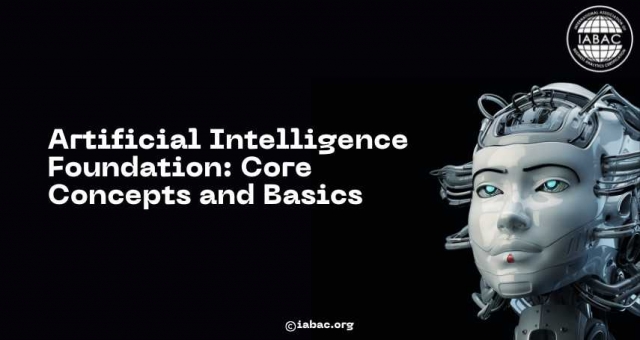One of the latest and most interesting areas of technology is artificial intelligence. Artificial intelligence (AI) has entered each part of our daily lives, from self-driving cars to virtual assistants like Siri and Alexa. However, what is artificial intelligence, and how can beginners understand its fundamental ideas? This is to simplify the fundamentals of artificial intelligence so that anybody may understand the basis of this interesting technology.
What is Artificial Intelligence?
At its core, Artificial Intelligence refers to the ability of machines or software to perform tasks that usually require human intelligence. These tasks can include:
- Learning: The ability to learn from data and improve over time.
- Reasoning: Solving problems logically and making decisions.
- Perception: Understanding the environment through vision, speech, or other sensors.
- Language Understanding: Interpreting and generating human language.
In simple words, AI allows machines to think, learn, and act intelligently, almost like a human.
Types of Artificial Intelligence
AI can be broadly categorized into three types based on its capabilities:
- Narrow AI (Weak AI)
Narrow AI is designed to do a certain task. Narrow AI includes, for example, chatbots, voice assistants, and Netflix or Amazon recommendation algorithms. Although they are intelligent in one area, they are unable to perform out activities beyond their original purpose.
- General AI (Strong AI)
General AI refers to machines that can perform any intellectual task a human can. This level of AI does not exist yet, but it is the ultimate goal for researchers.
- Superintelligent AI
This is a hypothetical future AI that surpasses human intelligence in every aspect. While exciting, superintelligent AI remains a concept for now.
Core Concepts of AI
To understand AI, it's important to learn some basic concepts that form its foundation.
Machine Learning is a subset of AI that allows machines to learn from data instead of being explicitly programmed. There are three main types:
- Supervised Learning: The machine learns from labeled data. Example: predicting house prices based on past sales data.
- Unsupervised Learning: The machine finds patterns in data without labels. Example: grouping customers based on shopping behaviour.
- Reinforcement Learning: The machine learns by trial and error, receiving rewards or penalties. Example: teaching a robot to walk.
Neural networks modeled after the human brain are used in deep learning, a unique kind of machine learning. For jobs like language translation, audio processing, and image identification, it is extremely powerful.
NLP focuses on enabling machines to understand and interact using human language. Examples include chatbots, virtual assistants, and language translation services.
Computer Vision allows machines to "see" and interpret visual information from the world, such as recognizing faces, objects, or even detecting diseases from medical images.
- Robotics
AI-powered robotics combines physical machines with intelligence to perform tasks automatically. Examples include warehouse robots, drones, and autonomous vehicles.
How AI Works: The Basics
AI works by combining three key elements:
- Data: AI systems need data to learn patterns and make decisions. More quality data generally leads to better performance.
- Algorithms: These are step-by-step procedures that allow machines to process data and learn from it.
- Computing Power: Modern AI requires powerful computers or cloud systems to process large amounts of data quickly.
The process typically looks like this:
- Collect Data: Gather data relevant to the problem.
- Train the Model: Use data to teach the AI system how to solve the task.
- Test and Validate: Check if the AI performs well on new, unseen data.
- Deploy: Use the AI system in the real world for practical tasks.
Common Applications of AI
AI has changed a lot of sectors. Among the most commonly used applications are:
- Healthcare: Diagnosing diseases, predicting patient outcomes, and developing new drugs.
- Finance: Detecting fraud, analyzing market trends, and automating trading.
- Retail: Personalizing recommendations and optimizing supply chains.
- Transportation: Self-driving cars and smart traffic management.
- Customer Service: Chatbots and virtual assistants to handle queries.
Benefits of AI
AI offers many advantages that can make life easier and businesses more efficient:
- Automation: AI can handle repetitive tasks, freeing humans for creative work.
- Decision Making: AI analyzes large datasets to provide insights for smarter decisions.
- Personalization: AI tailors experiences to individual preferences, such as personalized shopping recommendations.
- Problem-Solving: AI can solve complex problems faster than humans.
Challenges and Ethical Considerations
Despite its benefits, AI also comes with challenges:
- Data Privacy: AI systems require large amounts of data, raising privacy concerns.
- Bias: AI can inherit biases from data, leading to unfair decisions.
- Job Displacement: Automation may replace certain jobs, creating societal concerns.
- Safety: Advanced AI systems must be safe and reliable, especially in critical areas like healthcare or autonomous vehicles.
It is important to approach AI responsibly, ensuring ethical standards and fairness in development.
Getting Started with AI
If you are a beginner interested in AI, here's a simple roadmap:
- Learn the Basics: Understand core concepts like machine learning, neural networks, and NLP.
- Learn Python: Python is the most popular programming language for AI because of its simplicity and libraries like TensorFlow and PyTorch.
- Work on Projects: Start with small projects like chatbots, recommendation systems, or image recognition.
- Explore AI Tools: Familiarize yourself with AI platforms, cloud services, and open-source tools.
- Get Certified: Consider pursuing certifications such as the IABAC AI Certification to validate your skills and knowledge.
Future of AI
AI is continually evolving and has the potential to revolutionize industries, enhance human capabilities, and even solve global challenges. Emerging areas like explainable AI, AI in healthcare, and AI for climate change show how this technology is shaping the future.
However, AI's future success will depend on ethical development, responsible use, and collaboration between humans and machines.
Understanding the fundamentals of artificial intelligence is simpler than most people realize, despite its initial complexity. Anyone can begin learning about AI by understanding basic concepts like computer vision, NLP, deep learning, and machine learning.
AI skills will be growing in importance whether you're a professional, student, or business owner. You can start down the correct road by learning Python, working on modest projects at first, and following structured learning pathways like the IABAC AI Certification.
AI is a technology that is now here, developing, and changing the world; it is no longer merely a sci-fi fantasy. You too can participate in an AI-driven future if you have the knowledge and skills needed.






